When it comes to making traditional Irish food to help you celebrate St. Patrick’s Day, it doesn’t get much easier than this Irish Brown Bread Recipe. It is a simple bread recipe that is made and served throughout Ireland and is included as an option at nearly every meal.
The bread itself has a dense and hearty texture, with a slightly nutty flavor because one of the ingredients is whole wheat flour. It is a staple in Irish cuisine and is a staple of a traditional Irish breakfast or as an accompaniment to soups, stews, and other meals.
Best of all, this bread doesn’t require any yeast and therefore, doesn’t require time to rise before you can put it in the oven. Instead, it is leavened with baking soda and when combined with buttermilk it reacts which causes the bread’s rise and texture when put in the oven.

Irish Brown Bread vs. Irish Soda Bread
The rising process is basically the same as when making Irish Soda Bread. However, the two bread varieties, although both traditional Irish breads, differ in their ingredients, texture, and taste.
- Ingredients:
Irish Brown Bread: The primary ingredient is whole wheat flour, but often includes a mixture of white and whole wheat flours. It includes other ingredients such as buttermilk, baking soda, salt, and sometimes honey or molasses for added sweetness.
Irish Soda Bread: Soda bread includes a mixture of all-purpose flour, baking soda, salt, and buttermilk. Some variations may take the bread to a sweeter version by adding raisins or currants creating what is often known as “spotted dog bread”.
- Texture:
Irish Brown Bread: It has a denser and heartier texture due to the use of whole wheat flour.
Soda Bread: Soda bread tends to have a somewhat lighter and crumbly texture.
- Flavor:
Irish Brown Bread: The inclusion of whole wheat flour gives Irish brown bread a more robust and nutty flavor.
Soda Bread: Soda bread has a mild and slightly tangy flavor from the buttermilk. The plain version is not as sweet as the sweetened varieties that may include raisins or currants.
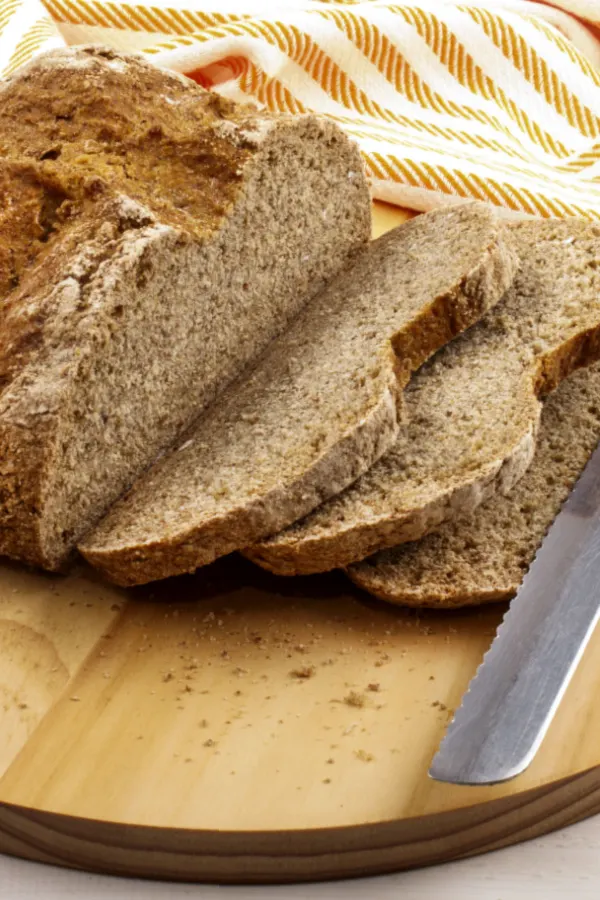
- Use:
Irish Brown Bread: Instead of being an individual course, this bread is part of a complete and hearty meal. It pairs well with soups, stews, and as an accompaniment to an Irish breakfast.
Irish Soda Bread: Versatile bread that is paired with either sweet or savory dishes. The sweet versions, with added fruits, are sometimes enjoyed as a snack or dessert or as part of breakfast served with jelly or jam.
How To Make Bread Rise Without Yeast
As mentioned before, bread can rise without the addition of yeast as long as you combine buttermilk and baking soda. Buttermilk is acidic due to the presence of lactic acid and baking soda is an alkaline base.
When you combine an acid with a base, it undergoes a chemical reaction that produces carbon dioxide gas. This gas then gets trapped in the dough, creating bubbles.
The carbon dioxide gas expands the dough, causing it to rise. This process is what leavens the bread, giving it a somewhat light and airy texture.
Unlike yeast, which requires time to ferment and produce carbon dioxide, the reaction between baking soda and buttermilk is much quicker. This makes it great for quick breads like Standard No Yeast Bread and Irish Brown Bread which can be baked shortly after mixing the ingredients.
The Baking Soda Test
However, in order to ensure that the bread rises, you must first be sure that your baking soda is active. Old baking soda will not react with the buttermilk and you will end up with a flat disc of hard bread dough.
Here are some ways to check if your baking soda is still good:
Expiration Date: Baking soda typically has a long shelf life, but it can lose its potency over time, especially if opened. Check the expiration date on the package. If it is no longer good, it’s best to replace it.
Visual Inspection: Look at the appearance of the baking soda. If it has developed clumps or has a hard texture, it most likely has absorbed moisture from the air and will be less effective.
Reactivity Test: Test to see if your baking soda is still good by putting a small amount of baking soda in a bowl and adding a few drops of vinegar or lemon juice. If the baking soda fizzes and produces bubbles, it is still active.
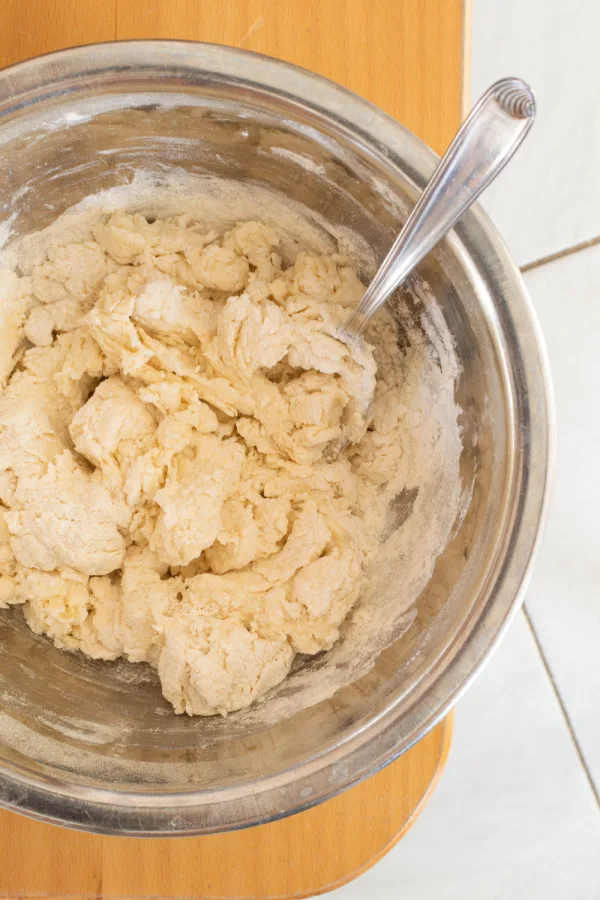
How To Make Irish Brown Bread
1. Combine The Ingredients – Start by whisking the dry ingredients and then slowly pour in the molasses and buttermilk until the dough forms.
2. Form The Dough – Once the dough comes together shape it into a round loaf.
3. Vent The Top – Be sure to use a sharp knife to vent the top of the loaf. Not only does this allow the moisture from the inside to escape, it actually helps the bread to bake more evenly.
4. Bake – Put the bread in the oven and let it bake.
How To Know When Bread Is Finished Baking
So how do you know when the bread is ready? Here are a couple of ways to ensure that your Irish Brown Bread is baked to perfection:
Golden Brown Color: The exterior of the bread will turn golden brown in color. This indicates that the outer crust has developed that crusty texture.
Tap Test: Once the bread comes out of the oven carefully and gently tap the bottom of the bread with your knuckles. If it sounds hollow, it’s a good sign that the bread is fully baked.
Internal Temperature: Using an instant read digital food thermometer, check the internal temperature of the bread. The center of the bread should register between190-200°F (88-93°C). For the novice bread makers. this is the only reliable way to ensure that the inside of the bread is fully cooked.
Skewer Test: Insert a skewer or long toothpick into the center of the bread. If it comes out clean or with a few dry crumbs (not wet or sticky), the bread is done. Although this seems like an easy way to tell doneness, it is best to use a food thermometer so that the bread doesn’t over bake.
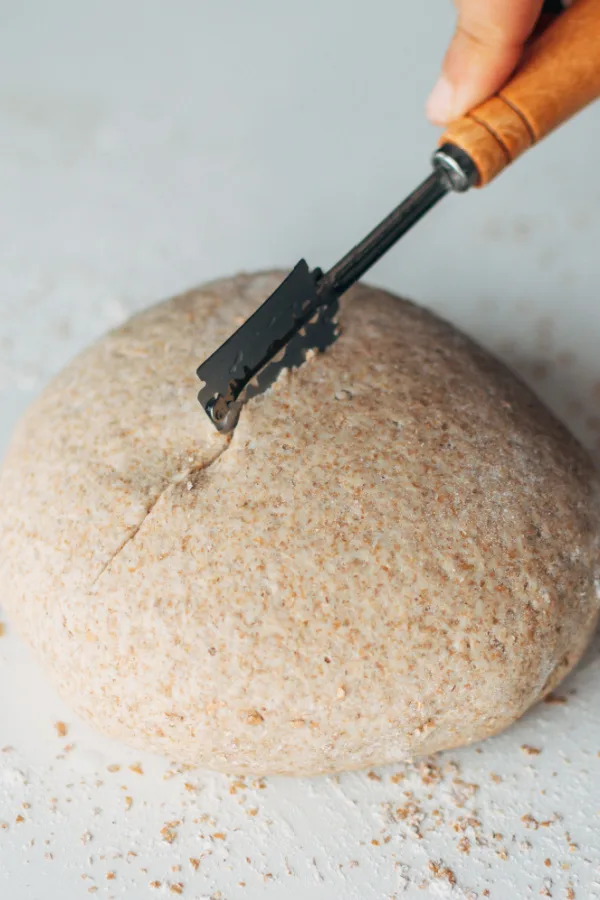
Irish Brown Bread Recipe
*A printable recipe card is located at the bottom of this article which contains the specific measurements, temperatures and cook times. However, continue reading below to learn about more helpful tips about this specific recipe.
INGREDIENTS
- 1 cup all-purpose flour
- 1⁄2 teaspoon salt
- 1 teaspoon baking soda
- 3 cups stone ground whole wheat flour
- 2 tablespoons molasses
- 1⁄2–3⁄4 pints buttermilk (approximately 1 1⁄4 – 1 3⁄4 cups)
INSTRUCTIONS
Start by preheating the oven to 400°F (200°C). Then, add the all-purpose flour, salt and baking soda into a medium bowl and whisk to combine.
Add the stone ground whole wheat flour to the bowl and whisk again.
Pour the molasses into the bowl and add 1 cup of buttermilk to the mixture. Stir until a soft dough forms, slowly adding more buttermilk as needed.
Turn the dough onto a lightly floured surface. Knead the dough just enough for it to come together. Do not over knead.
Form the dough into a round shape and place it on a lightly floured baking sheet. Vent the top of the bread by slicing a thin cross in the top center of the bread.
Place the baking sheet on the middle rack of the preheated oven and bake for 40 minutes. The bread is done if it sounds hollow when you knock it at the base or the bottom of the loaf.
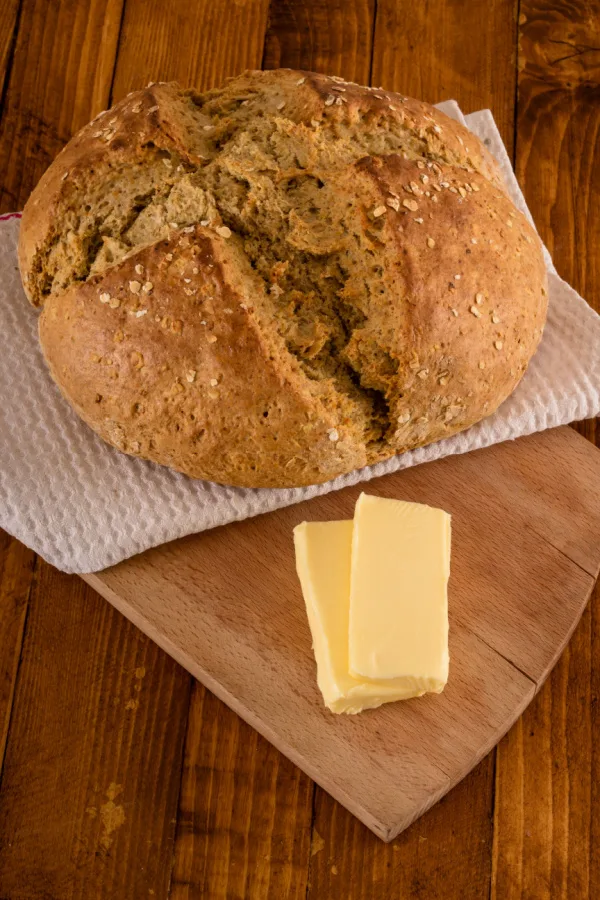
Remove the bread from the oven and place it on a wire cooling rack.
Optional: wrap a clean towel around the loaf as it cools if you would like a softer crust. Serve warm or at room temperature.
To Store:
Seal it inside a plastic bread bag or wrap in plastic wrap and store it at room temperature.
Enjoy! Mary
Follow My Facebook Page For Great Recipes For Two! I Cook For Two Facebook Page

To receive FREE recipes delivered directly to your email, be sure to sign up for the iCookfortwo newsletter. A sign up form is located in the middle of this article. If you have any questions, comments, or want to submit an idea for a recipe for two, feel free to email at mary@icookfortwo.com
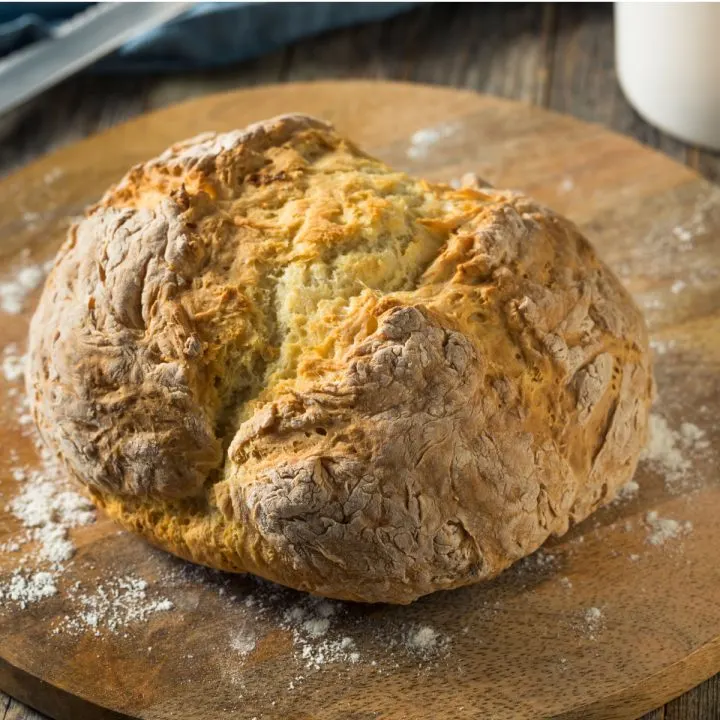
Irish Brown Bread
A staple bread in Irish cuisine, commonly served with soups, stews, or as part of a traditional Irish breakfast. This quick bread recipe requires no yeast and is completely made and on the table in less than an hour!
Ingredients
- 1 cup all-purpose flour, more for dusting
- 1/2 teaspoon salt
- 1 teaspoon baking soda
- 3 cups stone ground whole wheat flour
- 2 tablespoons molasses
- 1 - 1 1⁄2 cups buttermilk
Instructions
Start by preheating the oven to 400°F (200°C). Then, add the all-purpose flour, salt and baking soda into a medium bowl and whisk to combine.
Add the stone ground whole wheat flour the bowl and whisk again.
Pour the molasses into the bowl and add 1 cup of buttermilk to the mixture. Stir until a soft dough forms, slowly adding more buttermilk as needed.
Turn the dough onto a lightly floured surface. Knead the dough just enough for it to come together.
Form the dough into a round shape and place it on a lightly floured baking sheet. Vent the top of the bread by slicing a thin cross in the top center of the bread.
Place the baking sheet on the middle rack of the preheated oven and bake for 40 minutes. The bread is done if it sounds hollow when you knock it at the base or the bottom of the loaf.
Remove the bread from the oven and place it on a wire cooling rack.
Optional: wrap a clean towel around the loaf as it cools if you would like a softer crust.
Notes
Recipe provided by iCookfortwo.com
Nutrition Information
Yield 8Amount Per Serving Calories 244Total Fat 2gSaturated Fat 0gTrans Fat 0gUnsaturated Fat 1gCholesterol 2mgSodium 380mgCarbohydrates 50gFiber 5gSugar 6gProtein 9g
Nutritional Information is to be used as a general guideline only . Nutritional calculations will vary from the types and brands of the products used.
